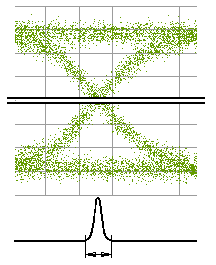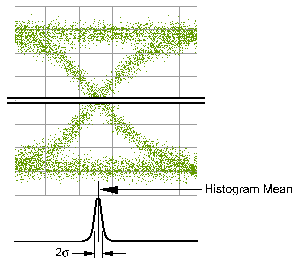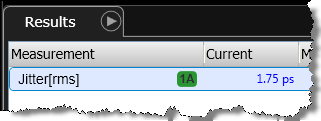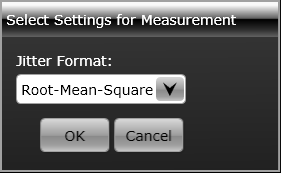Jitter

 The Eye mode Jitter is the measure of the time variances of the rising and falling edges of an eye diagram, as these edges affect the crossing point of the eye.
The Eye mode Jitter is the measure of the time variances of the rising and falling edges of an eye diagram, as these edges affect the crossing point of the eye.
One annotation label is placed at the start of the jitter and one on the end of the jitter. The labels are dependent upon the units defined. To compute jitter, the level of the crossing point of the eye is first determined. Then a vertically thin measurement window is placed horizontally through the crossing point, and a time histogram is generated. The histogram mean determines the center of the crossing points.
This measurement applies to NRZ waveforms and not to PAM4 waveforms.
If you have the enhanced jitter analysis option installed, take a look at the powerful Jitter Mode feature. Jitter Mode quickly separates jitter into its components and displays measurement results using tables and graphs.

It is possible to set the horizontal timebase setting too wide for a valid Jitter measurement to be made. In this case, zoom in on one edge of the waveform so that the trace width shows enough points for the instrument to construct an accurate histogram.
The measurement window is kept extremely small so that the width of the crossing point is not influenced by the rise time and fall time of the waveform. The amount of jitter on the waveform is directly related to the width of the crossing point. The histogram is analyzed to determine the amount of jitter. Jitter is measured and displayed in either of the following formats:
- Jitterp-p is equal to the full width of the histogram at the eye crossing point.

- JitterRMS is defined as ±1σ (standard deviation) of the crossing point histogram

 If the RMS format is selected, the measurement is listed in the table as Jitter[rms]. If Peak-to-Peak format is selected, the measurement is listed in the table as Jitter[p-p].
If the RMS format is selected, the measurement is listed in the table as Jitter[rms]. If Peak-to-Peak format is selected, the measurement is listed in the table as Jitter[p-p].
This measurement applies to NRZ waveforms and not to PAM4 waveforms.
Configurable Measurement Parameters
None.
To measure
- Select Eye/Mask Mode.
- Click the toolbar's Eye Meas tab.
- Click Auto Scale in the menu bar.
- Click the More buttons to locate the Jitter button.
- Click the button and select the jitter format: Root-Mean-Square or Peak-to-Peak.

SCPI Command
:MEASure:EYE:JITTer